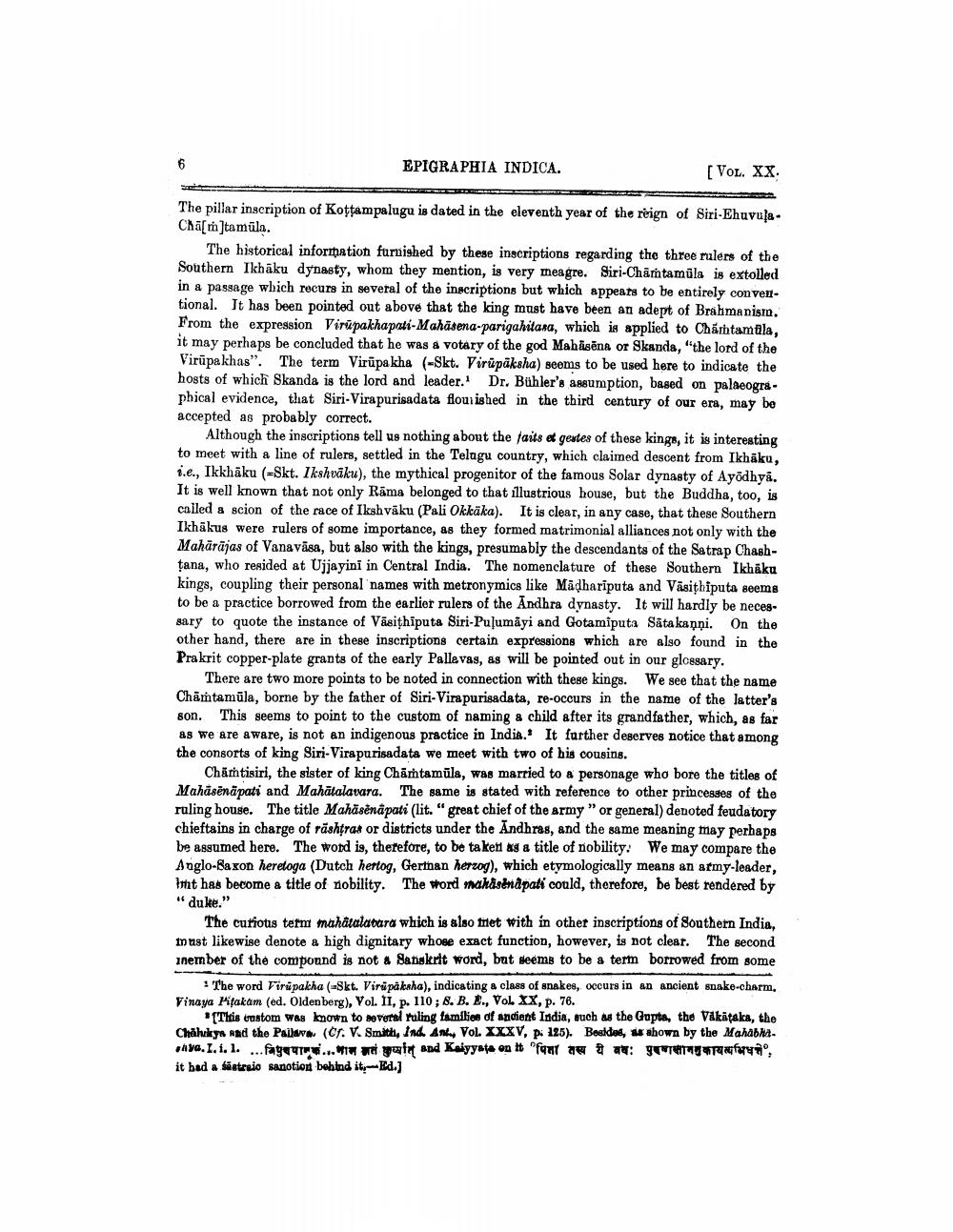________________
EPIGRAPHIA INDICA.
[Vol. XX
The pillar inscription of Kottampalugu is dated in the eleventh year of the reign of Siri-Ehuvula. Chā[m]tamūla.
The historical information furnished by these inscriptions regarding the three rulers of the Southern Ikhāku dynasty, whom they mention, is very meagre. Siri-Chämtamula is extolled in a passage which recurs in several of the inscriptions but which appeats to be entirely convertional. It has been pointed out above that the king must have been an adept of Brahmanisin. From the expression Virupakhapati-Mahasena-parigahitara, which is applied to Chámtamala, it may perhaps be concluded that he was a votary of the god Mahisēna or Skanda, "the lord of the Virūpa khas". The term Virūpa kha (-Skt. Virūpāksha) seems to be used here to indicate the hosts of which Skanda is the lord and leader. Dr. Bühler's assumption, based on palaeographical evidence, that Siri-Virapurisadata flourished in the third century of our era, may be accepted as probably correct.
Although the inscriptions tell us nothing about the faits et gestes of these kings, it is interesting to meet with a line of rulers, settled in the Telugu country, which claimed descent from Ikhäku, i.e., Ikkhāku (-Skt. Ikshvaku), the mythical progenitor of the famous Solar dynasty of Ayodhyå. It is well known that not only Rama belonged to that illustrious house, but the Buddha, too, is called a scion of the race of Ikshvāku (Pali Okkāka). It is clear, in any case, that these Southern Ikhākus were rulers of some importance, as they formed matrimonial alliances not only with the Mahārājas of Vanavāsa, but also with the kings, presumably the descendants of the Satrap Chashtana, who resided at Ujjayini in Central India. The nomenclature of these Southern Ikhäku kings, coupling their personal names with metronymics like Mädhariputa and Väsithiputa seems to be a practice borrowed from the earlier rulers of the Andhra dynasty. It will hardly be necessary to quote the instance of Vasithiputa Siri-Puļumāyi and Gotamiputa Satakanni. On the other hand, there are in these inscriptions certain expressions which are also found in the Prakrit copper-plate grants of the early Pallevas, as will be pointed out in our glossary.
There are two more points to be noted in connection with these kings. We see that the name Chämtamūla, borne by the father of Siri-Vira purisadata, re-occurs in the name of the latter's son. This seems to point to the custom of naming & child after its grandfather, which, as far as we are aware, is not an indigenous practice in India. It further deserves notice that among the consorts of king Siri-Virapurisadata we meet with two of his cousins.
Chăttisiri, the sister of king Chămtamūla, was married to a personage who bore the title of Mahāsēnā pati and Mahātalavara. The same is stated with reference to other princesses of the ruling house. The title Mahäsënå pati (lit." great chief of the army " or general) denoted feudatory chieftains in charge of răshtrax or districts under the Andhrag, and the same meaning may perhaps be assumed here. The word is, therefore, to be taken as a title of nobility. We may compare the Anglo-Saxon heretoga (Dutch hertog, Gertnan herzog), which etymologically means an atmy-leader, It has become a title of nobility. The word makåsenapati could, therefore, be best rendered by "duke."
The curiotus tem mahatalabard which is also frlet with in other inscriptions of Southern India, must likewise denote a high dignitary whose exact function, however, is not clear. The second inember of the compound is not a Sanskrit word, but seems to be a term borrowed from some
The word Firúpakha (Skt. Virupaksha), indicating a class of snakes, occurs in an ancient snake-charm, Vinaya Mipakam (ed. Oldenberg), Vol. II, p. 110; 8. B. E., VOL XX, p. 76.
(This vastom was known to Moveral ruling families of ancient India, such as the Gupta, the Vakitaka, the Chihukyn and the Pall.. (Cr. V. Smith, Ind. An. VOL. XXXV, p. 125). Bealdes, u shown by the Mahabm. v.1.1.1. ...fagauty ... WW w point and Keiyyata en "four yu #w: ga
r a , it bad a sastrais sanotion behind itd.)




